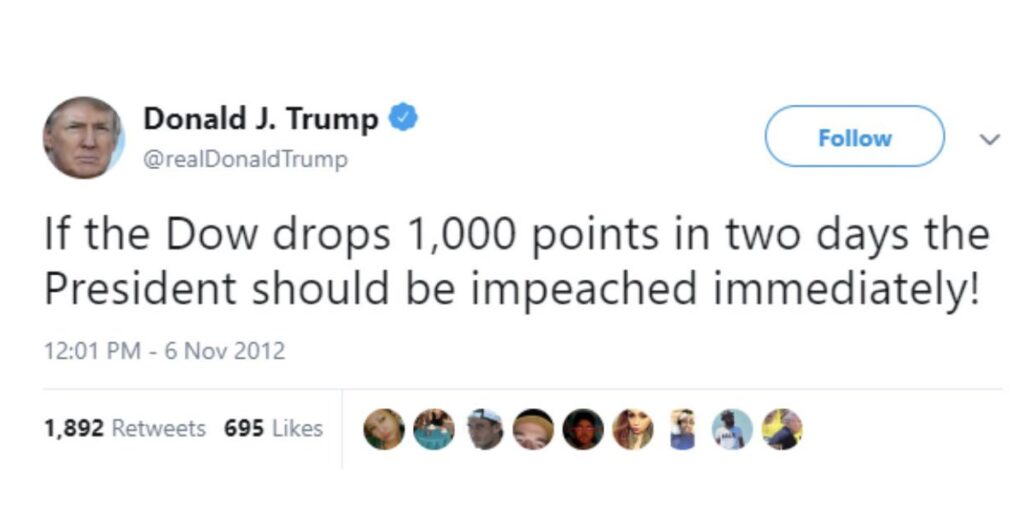When it comes to screenshots of tweets, don’t be a credulous idiot
The Dow dropped 1,000 points yesterday, crashed by fears about the Coronavirus. And two screenshots of past Trump tweets spread like wildfire. This is a situation where the urge to share led many astray — and it’s pernicious, regardless of what side of the political divide you land on.
Here are the two screenshots that spread:


Are they real?
The first one looks pretty suspicious. While Trump’s tweets often contain errors, putting “points” and “loaded” in quotes, misspelling “Jones” and the silliness of shooting a president into the sun from a cannon should tip you off that something’s not quite right here. And sure enough, the cannon tweet is an admitted fabrication by Shaun Usher, of the Letters of Note blog.
But what about the second one? That looks pretty plausible.
Snopes debunks the 1,000-point tweet
Snopes casts doubt on the second tweet, calling it “unproven.” These are the facts that Snopes discovered:
- It purports to be published on the date after a two-day, 1,000-point drop in the Dow.
- It’s not in Trump’s timeline. That means that if it ever existed, it was deleted.
- There is only one screenshot of the tweet — the one I’ve shown. No one else has shared a record of it.
- There is no record of it before 2018.
- The first person who posted it has posted many other fake tweets in the past.
Sure, its conceivable that the tweet is real (which is why Snopes called in “unproven,” rather than false.)
But which of these do you think is more likely?
- Trump wrote the tweet in 2012, but no one took a picture of it. He deleted it before he started to run for president, at which point people started to archive his tweets including those subsequently deleted. He rarely goes back and deletes old tweets, only new ones, but he did in this case. Only one person took note. That person happens to be a person who shares false information all the time. And he waited to share this until just the right moment, when the stock market dropped.
- The person who shared it used one of the many easily accessed fake tweet generators, then took a screenshot to fool people, just as he has with many other false tweets.
Face it. It’s fake.
Many of you were fooled
About a dozen of my Facebook and Twitter friends shared the second fake tweet. This includes a liberal person I went to high school with, who is regularly fooled into sharing fake stuff about Trump.
One of my friends posted it, then realized his error and posted the Snopes debunking.
I posted the Snopes article as a comment on the post of another friend, and one of his friends attacked me, saying that it wasn’t “proven” that it was fake.
Trump posts stupid things and lies all the time. And it’s terrifying. Is this tweet accurate?
This is worth discussing. Fake tweets are not.
If you post fake crap and defend it by saying “it could be true,” you are part of the problem. Stop looking around for someone to blame. It’s loads of fun to believe in fantasies, but with Russian trolls doing their best to divide America, this is not time to be confusing parodies and fabrications with truth.
If it looks suspicious, check first. It doesn’t make a difference who duped you; liberal fakes and pro-Trump fakes are equally evil. If you find out you got fooled — it happens! — delete it and post a correction.
There are enough credulous idiots shouting about this election. You’re smarter than that.
I really enjoy your daily emails with your take on various things, and I especially appreciate this reminder to be cautious about what may be posted on Facebook and other social network platforms. I wish I found your blog/book years before I did – it would have saved me quite a bit of criticism about my overly long work emails. 🙂
Thanks!
It is literally impossible to check everything that looks suspicious. I’m not condoning the reposting of false stories and images and tweets. But I am saying that half the news stories I’ve read (and I read a lot) since 2016, have sounded like they came from The Onion. It is really, really hard to know what’s real and what’s not. And checking everything would be a full-time job, and then some.
So perhaps the message, Aaron, is that you shouldn’t repost/retweet anything you’re not able to verify. Our commitment to that principle alone would reduce significantly the amount of false information out there.
Guys… the font on the second tweet is the biggest giveaway that it is a fake.
Soon there will be videos of someone (e.g. the President) saying something just as fake as these tweets, where the image convincingly appears real, and the audio sounds real.
We all should be much more skeptical than we are.
I’ve had people tell me things that, on the surface, just didn’t make sense. Often, I later find out it was some fake report posted on social media.
People need to hone their BS detector, but many won’t because misinformation like the examples above feeds / entertains their own biases.
As Steve above replied to Aaron, folks need to refrain from passing along junk.
Only, most won’t.
They are comfortable in their information bubble, consuming content they want to hear, believing they are the “informed” ones (not matter which side of the aisle they are).
What to do?
Set an example. Be the standard. Don’t get sucked into, or play that game.